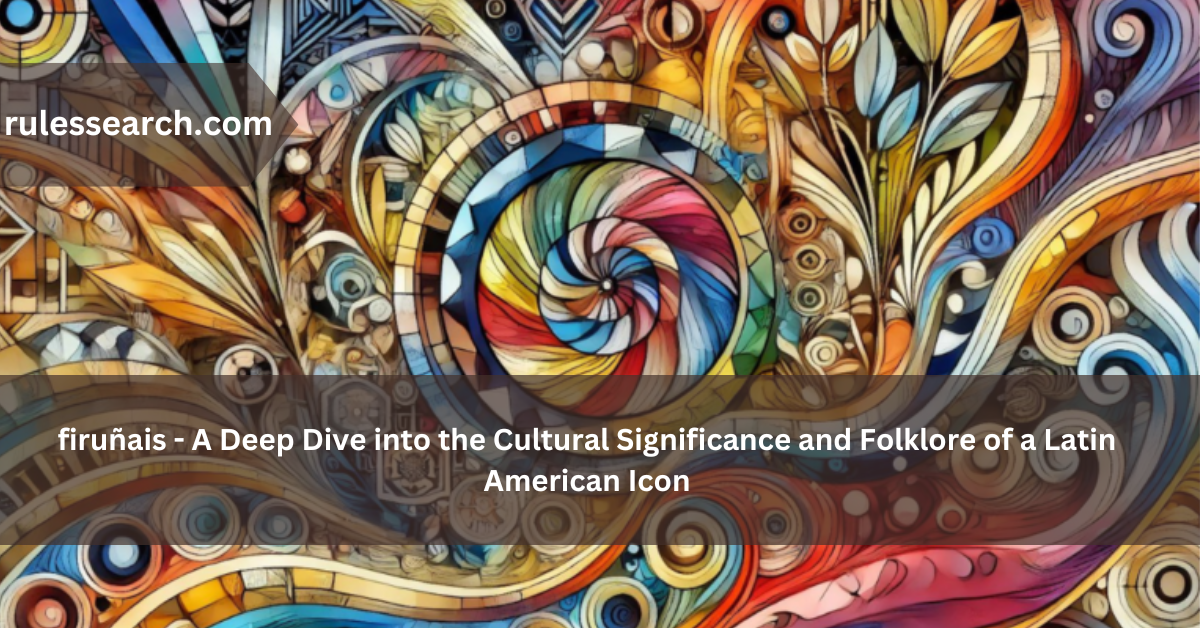The term “Firuñais” or more commonly “Firulais” holds a unique place in Latin American, particularly Mexican, culture. Often associated with stray dogs or those without a name, this seemingly simple word is woven into a rich cultural tapestry filled with folklore, humor, and social commentary. While it might seem like a playful moniker, Firuñais carries with it layers of meaning that reflect the attitudes and values of society regarding animals, identity, and community.
In this article, we’ll explore the origins of the term, its cultural evolution, and how it has come to represent much more than just an unnamed dog. Along the way, we’ll uncover the role of Firuñais in popular culture, folklore, and even as a mirror of societal attitudes. Whether you are familiar with the term or encountering it for the first time, the journey into the world of Firuñais offers fascinating insights into Latin American culture that are just as relevant to readers in the USA.
The Origins of “Firuñais”
Linguistic Roots
The origins of Firuñais are somewhat murky, but most historians agree that it is a playful distortion of the English phrase “free of lice,” or “free of fleas,” humorously referencing stray dogs, many of which are known to suffer from parasitic infections. Over time, the phrase was adapted into the Spanish-speaking world, evolving phonetically to become “Firulais” or “Firuñais.” While it might seem like an odd evolution, this linguistic shift is a hallmark of how language can transform in new cultural contexts.
In its earliest uses, Firuñais was often used in jest, referring to dogs that wandered the streets without owners. In rural and urban Mexico, dogs have often been a common sight on the streets, making them an intrinsic part of the cultural landscape. However, the term transcended its literal meaning to carry more weight in the realms of humor, endearment, and even social critique.
Folkloric and Cultural Significance
Over time, Firuñais became more than just a word for stray dogs. It evolved into a piece of folklore that reflected societal attitudes towards dogs, animals, and those who exist on the margins of society. In a sense, to call a dog a Firuñais is to recognize it as an outsider, a creature without formal ties but still deeply woven into the fabric of daily life.
For many, Firuñais represents resilience and adaptability, traits often admired in Mexican culture. Stray dogs must fend for themselves, often forming loose packs and surviving on the scraps of the city. In this way, the Firuñais mirrors the struggles of people who face hardships but remain an essential part of the community. Through humor and familiarity, the term has become a term of endearment, often associated with dogs that may be nameless but are certainly not unloved.
The Role of Firuñais in Popular Culture
Firuñais in Film and Media
Latin American popular culture has embraced the figure of the Firuñais in various forms of media, from films to TV shows. In many Mexican telenovelas, cartoons, and movies, the Firuñais often makes a cameo appearance, adding a touch of humor and relatability to the story.
One well-known example is from the Mexican TV series “Chespirito,” where a character might refer to an unnamed dog as Firulais. These representations help solidify the cultural image of Firuñais as a symbol of loyalty, humility, and the everyday challenges of life.
The Humor and Social Commentary of Firuñais
What makes Firuñais especially interesting is the way it has evolved as a term of both humor and social commentary. Often, the term is used to describe someone or something as being unloved, unwanted, or without status — similar to the status of stray dogs in society. However, this doesn’t carry a negative connotation. In many cases, it’s a term of affection or even admiration for the resilience shown by those who are often overlooked.
In a world that can be harsh, the Firuñais becomes a symbol of persistence. Whether wandering the streets or making cameo appearances in popular culture, the Firuñais reminds us of the untold stories and overlooked members of society — both human and animal.
The Cultural Evolution of Firuñais
Firuñais as a Social Mirror
Interestingly, the term Firuñais has evolved to reflect not only how people view animals but also societal structures. The stray dog in Latin American culture often exists outside the formal boundaries of ownership, belonging neither to an individual nor to the state. In this way, the Firuñais can be seen as a symbol of those who exist on the fringes of society — the homeless, the forgotten, and the marginalized.
By using humor to highlight this reality, the term softens the harshness of life on the streets, offering a compassionate and humanizing view of stray animals. Moreover, it reminds people of the shared responsibility of caring for those who cannot care for themselves, whether they be dogs or humans.
Changing Attitudes Towards Stray Dogs
In recent years, there has been a shift in attitudes towards stray dogs in Mexico and across Latin America. Animal rights organizations have worked to improve the conditions for stray animals, promoting adoption and responsible pet ownership. The once-dismissive attitude toward Firuñais has started to change, with many people taking in stray dogs and giving them the homes they deserve.
Despite this positive shift, the cultural significance of Firuñais remains intact. Even adopted street dogs are often lovingly referred to by this name, showing how deeply embedded it is in the collective consciousness. For many people, adopting a Firuñais symbolizes giving a second chance to an animal that has survived against the odds.
Firuñais in the Modern World
A Global Symbol of Resilience and Humor
Though the term Firuñais is distinctly Latin American, its themes of resilience, survival, and humor are universally relevant. For a U.S. audience, understanding Firuñais offers a window into Mexican and broader Latin American culture, particularly how people view animals and those who live on the fringes of society.
The concept of stray animals and their relationship to communities is something many people in the U.S. can relate to. Cities across the country have their own challenges with stray animals, and efforts to improve their treatment have led to widespread animal welfare movements. In this sense, the Firuñais is a reminder of the global struggle to balance compassion with action, ensuring that even those without a voice are given a chance at a better life.
Lessons from Firuñais for Animal Welfare in the USA
The evolution of attitudes toward stray dogs in Latin America mirrors a broader global shift toward more humane treatment of animals. In the U.S., animal shelters, rescue organizations, and adoption events have gained traction, focusing on the importance of caring for strays and encouraging responsible pet ownership.
By learning from the cultural journey of Firuñais, U.S. readers can deepen their understanding of the need for compassion in dealing with strays. Whether it’s a nameless dog on the street or a misunderstood figure in society, the Firuñais teaches us the value of giving second chances and showing kindness where it is most needed.
Conclusion
The word Firuñais may have started as a playful reference to street dogs, but over time, it has grown into a rich symbol of resilience, humor, and the complexities of life on the margins. Its presence in popular culture, its role in folklore, and its relevance to animal welfare movements show that this term is far more than a simple nickname — it is a reflection of the human spirit.
Whether you encounter Firuñais on the streets of Mexico or in a story told in the USA, it serves as a reminder that even those who seem forgotten or unloved have a place in the world. They are survivors, worthy of our attention and care.
FAQs
1. What does Firuñais mean?
Firuñais is a term commonly used in Mexico and Latin America to refer to stray dogs. It originated from a playful distortion of the English phrase “free of fleas,” symbolizing unnamed or unowned dogs.
2. Where did the term Firuñais come from?
The term is believed to have evolved from the phrase “free of fleas” and entered the Mexican lexicon as a reference to stray dogs. It has since become a widely recognized term with cultural significance.
3. Why is Firuñais culturally significant?
Firuñais carries deep cultural meaning in Latin America, representing not only stray dogs but also reflecting societal attitudes toward the marginalized. It symbolizes resilience and humor in the face of hardship.
4. How has Firuñais evolved in popular culture?
Firuñais has appeared in various forms of Latin American media, from television shows to movies, where it often represents a lovable but scrappy underdog.
5. What does Firuñais symbolize?
The term symbolizes survival, adaptability, and the need for compassion, both for animals and for those who live on the fringes of society.
6. Is Firuñais used outside of Latin America?
While the term is most common in Latin American countries, it has cultural resonance worldwide, particularly among those familiar with Latin American culture and its representations of stray dogs.
7. Are attitudes toward stray dogs changing in Latin America?
Yes, in recent years, attitudes toward stray dogs have shifted, with more focus on animal welfare, adoption, and responsible pet ownership.
8. How can U.S. readers relate to the concept of Firuñais?
U.S. readers can relate to the concept of Firuñais through the global issue of stray animals and the need for humane treatment. The resilience and humor associated with Firuñais are universal themes.
9. What role does Firuñais play in folklore?
In folklore, Firuñais often serves as a symbol of the underdog, representing the marginalized or overlooked members of society while also being a figure of humor and endearment.
10. How can we help stray dogs like Firuñais?
One of the best ways to help stray dogs is through adoption, supporting animal welfare organizations, and promoting responsible pet ownership to ensure that every dog, like Firuñais, gets a chance at a better life.



